
22 Iranian Desserts You Have to Try
Persian desserts hold a special charm for food lovers worldwide. Rooted in a tea-loving culture, these sweets are perfect companions for celebrations or simply savoring during your daily tea break. If you have a sweet tooth, get ready to indulge in a delightful experience.
In this post, we’ll take you on a unique culinary adventure, showcasing the best sweets Iran has to offer. Let’s explore how to prepare and serve these treats, perfect for impressing any crowd in no time.
Here are 22 irresistible Iranian desserts and sweets you must try.
What Makes Iranian Desserts So Special?
Iranian desserts stand out for their rich flavors, unique textures, and savory twists. Each one is distinct, offering something special depending on its region of origin. From Iranian baklava to rice puddings, ice creams, and traditional cakes, there’s a wide range of sweets to satisfy every taste.
Iranian pastries are famous for their rich saffron flavor, making them truly irresistible. Known for their intense sweetness, they also feature a subtle rosewater aroma that adds to their charm.
Sugar didn’t reach Europe until after the first century AD, but it first made its way to the Middle East. Before sugarcane became widely used, honey and fruits like dates, apricots, and pomegranates were the primary sources of sweetness. Iranian desserts are enriched with a delightful mix of pistachios, almonds, and sesame seeds, complemented by the aromatic essence of rosewater, orange blossom, saffron, and cardamom.
Confections were once symbols of culinary prestige, often presented on gold-plated dishes or in intricately woven ivory baskets, creating an aromatic atmosphere that many ancient civilizations would have appreciated. The culture of sweetness in Persia was not only about flavor but also about elegance and innovation. In fact, the earliest ice cream-like treats, dating back to 550 BC, are believed to have originated in ancient Persia.
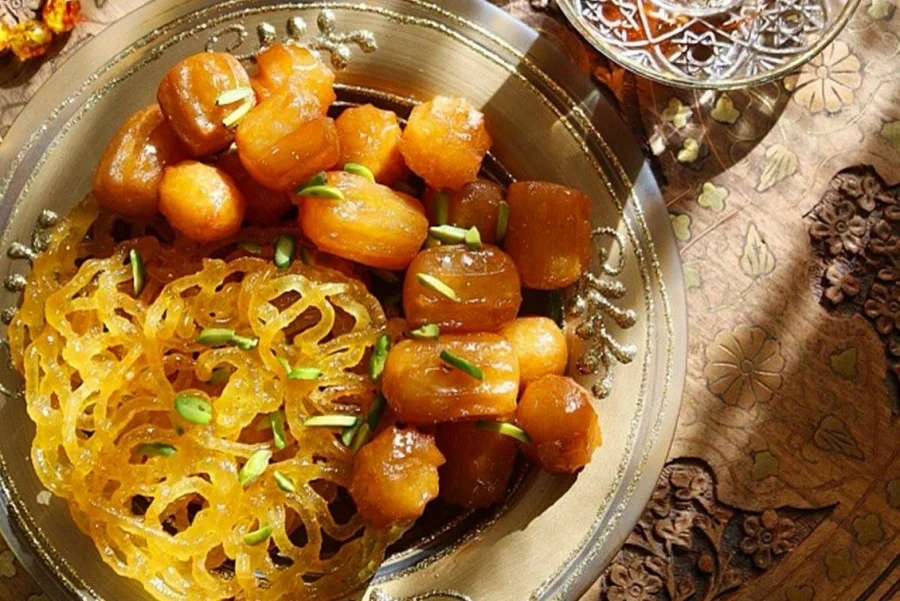
How the Silk Road Shaped Persian Sweets?
The Silk Road was instrumental in linking ancient Iranian civilizations with China, facilitating both trade and cultural exchange. This trade route allowed goods such as grains, fruits, vegetables, and spices to travel across vast distances by land and sea. As these ingredients arrived in new regions, they were blended into local cuisines, influencing the development of distinctive Persian sweets that reflect this rich history of cross-cultural interaction.
Many commonly used herbs, like basil and cilantro, along with popular dishes such as sweet and sour sauces and almond desserts, trace their origins back to Iran. Iranian sweets have been influenced by Indian and Chinese cuisines, and in turn, they have left a lasting impact on the desserts of these countries, as well as those in the West. Even the names of some vegetables and fruits, such as lemon and pistachio, have Persian roots.
Exploring the Regional Flavors of Iran’s Sweets
Traveling through Iran’s provinces offers a glimpse into the country’s diverse cultural and natural heritage, and this is reflected in its wide variety of desserts. Each region has its own specialty, like the delicate Pashmak from Yazd, the famous Gaz from Isfahan, and the fragrant Berenji from Kurdistan, offering a unique taste of Iran’s rich culinary traditions.
What Makes Iranian Desserts Unique: Key Ingredients
1. The Magic of Saffron in Iranian Desserts
Saffron, known as “Red Gold,” is a treasured ingredient in Iranian cuisine, renowned for its rich history and distinctive flavor. Iran is the top producer of saffron, supplying over 90% of the world’s stock. With 390 tons of saffron harvested and sold annually, Iran leads the global market, making it a key ingredient in many of the country’s iconic desserts.
Saffron is a marvelous ingredient in both savory dishes and traditional ice cream, with just one gram coming from 500 individual stigmas. Iranian saffron producers also craft a variety of delicious and potentially health-boosting saffron-based products, such as saffron pudding, saffron rock candy, saffron cake mix, saffron jelly, and the beloved saffron tea.

2. The Role of Rose Water in Iranian Sweets
Rose water, or “Golab,” is a key ingredient in many traditional Iranian sweets. It’s loved for its sweet, fragrant aroma and is used in desserts to add a calming, floral touch. Whether in pastries, drinks, or ice cream, rose water enhances the flavors and creates a distinctive taste in Iranian cuisine.
During celebrations, Iranians make an array of halvas and pastries, all beautifully flavored with rose water.
In Iran, the two favorite ice cream flavors are the classic saffron and the refreshing Faloodeh. The latter is often served with a squeeze of lime juice from a bottle. Refreshing and cool, it’s the perfect way to end a delicious meal, made with the finest ingredients.
Rose water is also used in Iran to subtly flavor cold beverages, tea, biscuits, and other sweet treats. Its subtle fragrance brings a special flavor to many dishes.
3. The Health Benefits of Iranian Nuts and Dried Fruits
Iranian dried fruits, dried naturally in the sun or with specialized dryers, retain much of their nutritional value. Iranian nuts, known for their hard shells and nutrient-packed seeds, are not only tasty but also rich in vitamins and minerals. Both dried fruits and nuts are excellent sources of potassium, fiber, and bioactive compounds that promote good health.
They are commonly used in Iranian cookies, sweets, ice creams, and various other unique desserts.
22 Iranian Desserts You Have to Try
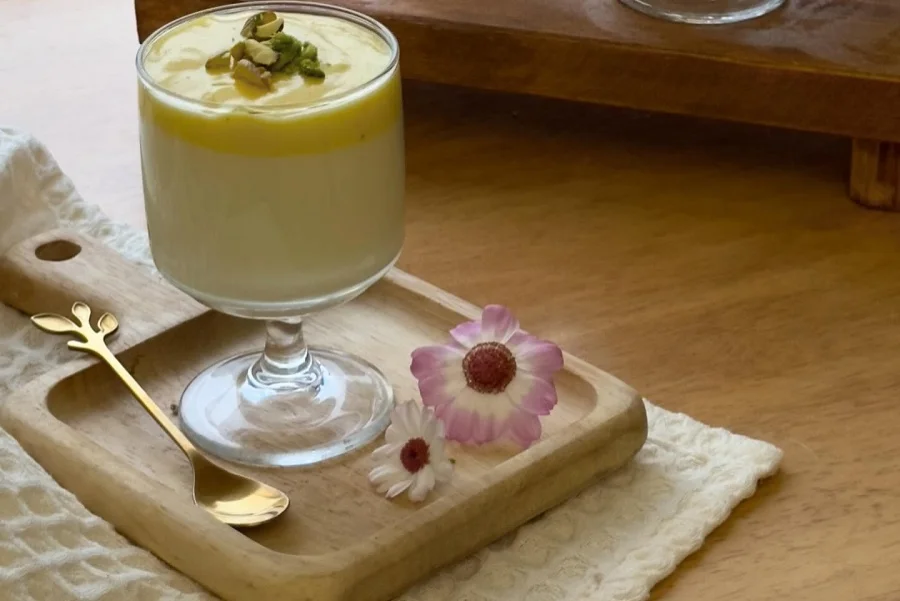
1. Shole Zard
Shole Zard, affectionately known as “yellow pudding,” is a cherished rice dessert in Iran. Sometimes spelled as Sholeh Zard, this traditional dessert boasts a delicate texture and a rich Persian flavor profile. It’s typically served in a glass and garnished with pistachios and cinnamon powder, making it both delicious and visually appealing.
As Shole Zard is presented, the enchanting fragrance of saffron and rose water wafts through the air. This simple yet satisfying dessert is especially popular in Iran during Ramadan. However, traditional Iranian sweets like this can be enjoyed throughout the year.

2. Faloodeh
Faloodeh, a semi-frozen treat, is a beloved regional delicacy in Iran, especially popular as a summertime street food. Made with vermicelli noodles, sweet rose water syrup, and a squeeze of lime, this Persian dessert offers a unique combination of flavors. The sweetness of the rose water blends perfectly with the tangy hint of lime, creating a refreshing treat you won’t want to miss.
For a soul-refreshing escape from the heat, Faloodeh is the perfect choice. You can find this delightful treat at almost any local ice cream parlor.
Looking for more? Explore some popular Iranian snacks that people enjoy throughout the day, or check out our article on famous Iranian cuisine for a deeper dive into the country’s culinary delights.
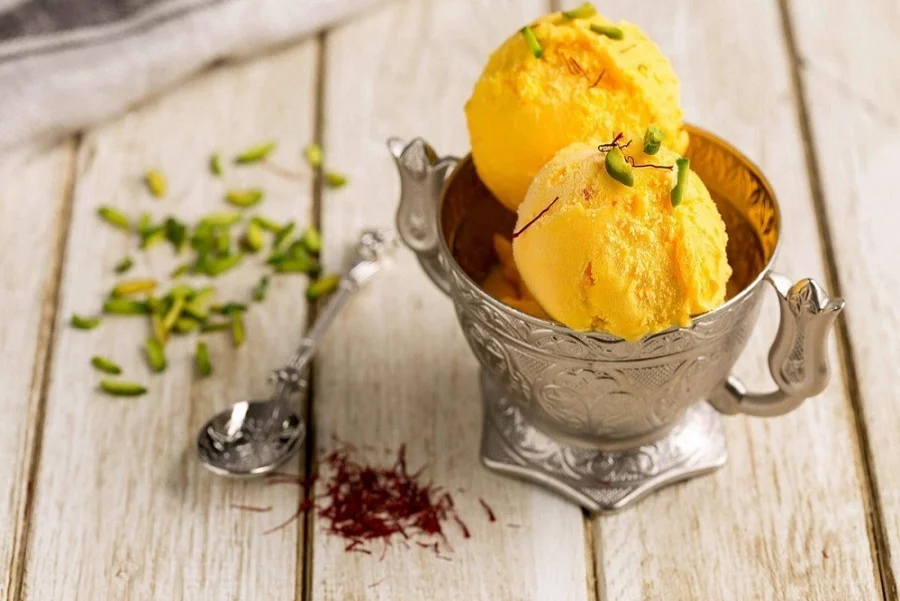
3. Bastani Sonnati
If you visit Iran and don’t try Bastani Sonnati, you’re truly missing out. This traditional Iranian ice cream is a must-have dessert and holds a special place in the hearts of locals. Loved by everyone, it’s often considered the nation’s signature ice cream.
Bastani Sonnati is a delightful alternative to classic vanilla, chocolate, or strawberry ice creams. Its ingredients and preparation are simple, yet the natural flavors of saffron, rosewater, and mastic make it uniquely exceptional, setting it apart from other Iranian desserts.
With its bright yellow color and the aromatic blend of saffron, rosewater, and mastic, Bastani Sonnati is both eye-catching and flavorful. The mastic, a natural resin, gives it a distinct chewy texture. You can enjoy this traditional ice cream either scooped into a dish or tucked between two thin wafers for an authentic experience.

4. Zoolbia & Bamieh
Zoolbia & Bamieh is one of the oldest and most beloved Iranian sweets. The dish features two main parts: Zoolbia and Bamieh, which are always served together. Both are soaked in a fragrant syrup made from saffron and rosewater, adding a rich and aromatic sweetness to these crispy, fried treats.
In Iran, Zoolbia & Bamieh is a staple during the month of Ramadan due to its delicious sweetness. Its rich flavor makes it an essential treat for breaking fasts, enjoyed by families and communities throughout the holy month.
Like many other Iranian desserts, Zoolbia & Bamieh pairs perfectly with a steaming cup of Persian black tea, enhancing its rich sweetness and creating a comforting, flavorful experience.
5. Gaz
When buying Iranian sweets, make sure to include Gaz, a delicious treat from the Isfahan region. This popular confection is loved across Iran and makes for a perfect gift or a delightful treat for yourself.
Persian nougat, known as Gaz, is a popular treat outside of Iran. Made with roasted almonds, sugar, and egg whites, it creates a toffee-like texture. The result is a sweet, nutty flavor with a subtle rosewater undertone, offering a delightful combination of tastes.
6. Qottab
Qottab is a delicious treat filled with finely chopped almonds and walnuts, sweetened and deep-fried, then coated in powdered sugar. This unique dessert is a specialty of Yazd, offering a delightful crunch and rich flavor that sets it apart as one of the region’s most beloved sweets.
7. Halva
Halva holds a special place in Iranian culture, and while its recipes may vary, it is also enjoyed in countries like India and North Africa. The word “halva” comes from the Arabic term for “sweet,” and its preparation and use have evolved in Iran over time. Once made for rituals such as weddings and given as gifts, it is now more commonly prepared for funerals or as a religious offering. Despite this shift, Persian halva remains one of the most popular, delicious, and nutritious sweets in Iran.
8. Ranginak
Ranginak is a no-bake Persian dessert that makes for a perfect, well-rounded treat. Made with dates, walnuts, butter, and toasted flour, it’s both nourishing and energizing. Also known as date cakes, Ranginak is especially popular in the southern regions of Iran, where a variety of dates are grown and exported. Each region has its own unique take on this delightful, nutrient-packed dessert.
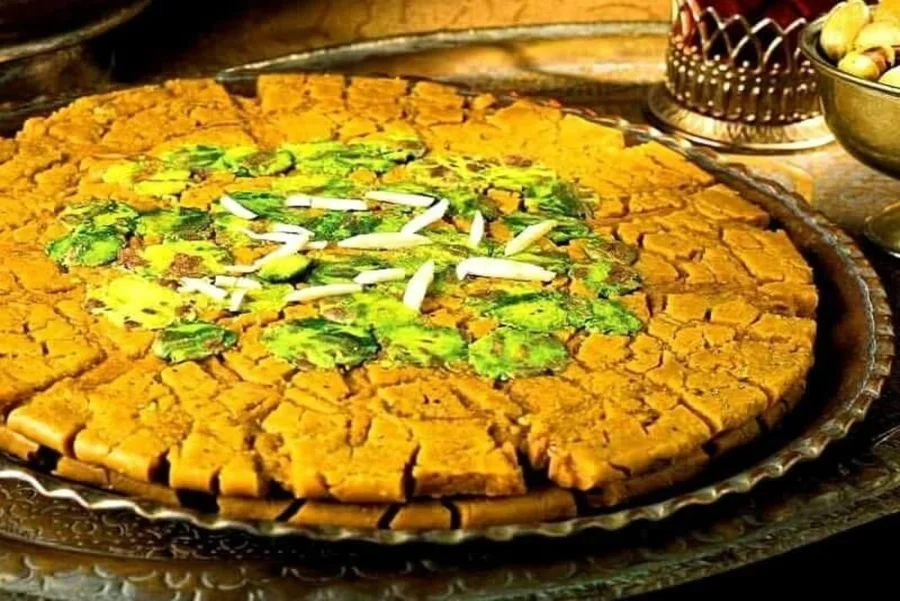
9. Sohan
Sohan is a special treat from Qom, Iran, made with unique Persian flavors like saffron and rosewater. Made with a blend of egg, wheat germ, sugar, butter, cardamom, and rosewater, Sohan is both flavorful and aromatic. It’s a popular treat and a great souvenir to bring back from Iran.
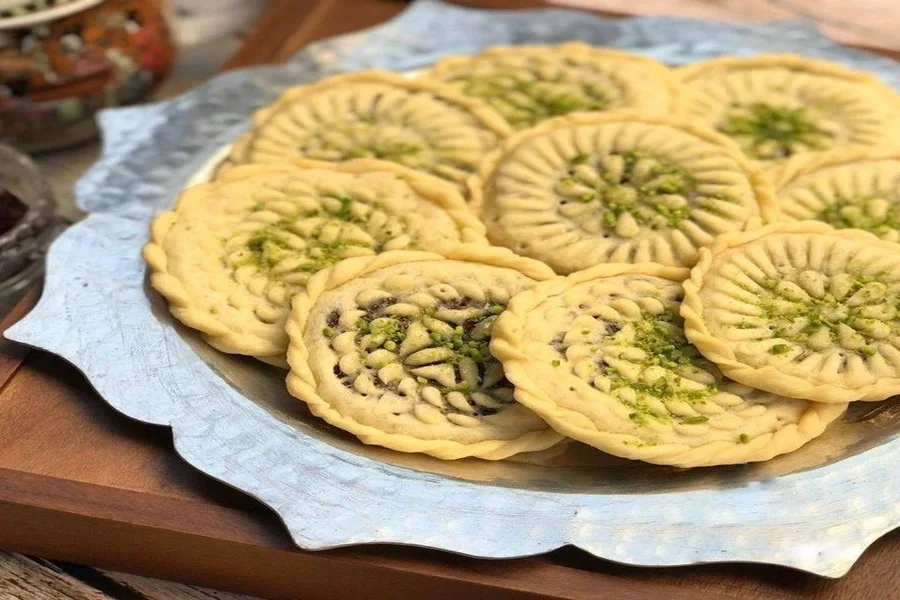
10. Kolompeh
Kolompeh is a small, round, flat cake from Kerman, filled with a mixture of ground dates, cardamom powder, and other regional spices. The cake is often decorated with crushed pistachios, adding a delightful crunch and enhancing its rich flavor. This traditional sweet is a perfect treat for those seeking something uniquely Iranian.
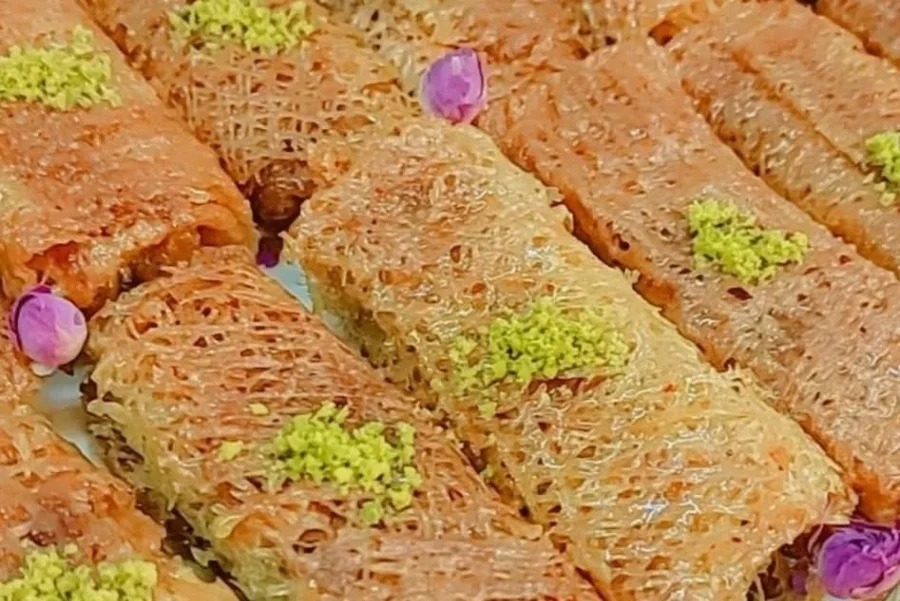
11. Reshteh Khoshkar
Reshteh Khoshkar is a traditional biscuit from Gilan Province, Iran, typically made during Ramadan. Made with rice flour, this treat is filled with a blend of sugar, cardamom, cinnamon, and ginger, then deep-fried in hot oil or fat. This flavorful, spiced treat is a cherished part of Iranian cuisine during the holy month.
12. Baghlava
Baghlava is a delicious, sweet delicacy enjoyed in Greece, Central Asia, and the Middle East. With a rich history dating back to ancient times, it has inspired hundreds of recipes over the centuries. This layered pastry, filled with chopped nuts and soaked in syrup, continues to be a beloved treat across many cultures.
Known as Baghlava in Iran, this sweet treat has adopted distinct characteristics from Persian cuisine. Unlike the versions from Turkey or the Arab world, Iranian Baghlava is lighter and drier, often cut into smaller, diamond-shaped pieces. It’s flavored with rosewater syrup and filled with crushed almonds, pistachios, and cardamom. The two main centers for Persian Baghlava are Yazd and Qazvin, where local variations of this delicious dessert are crafted with care and tradition.
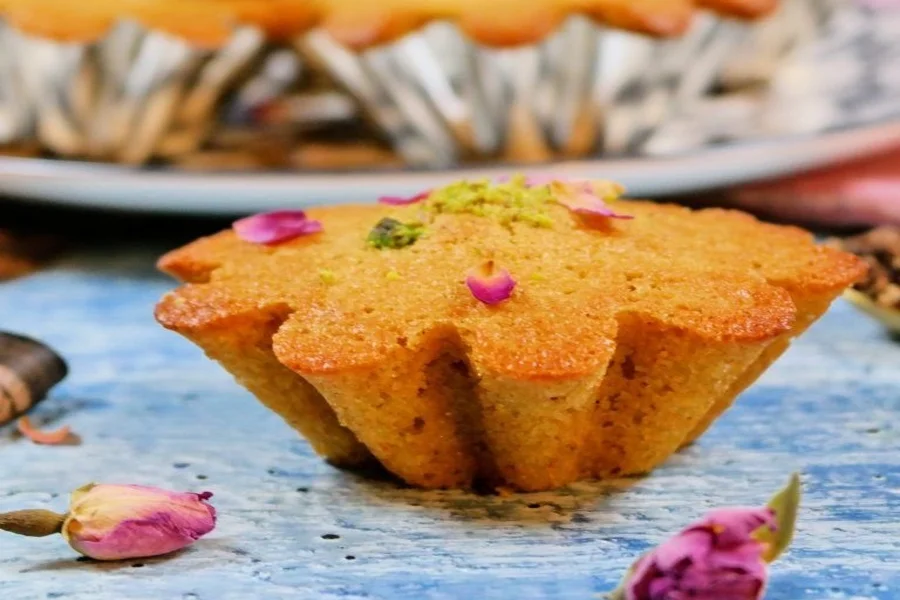
13. Yazdi Cupcake
Yazdi cupcakes are small, fluffy Persian desserts that offer a subtle sweetness. Although cupcakes are originally from the United States, the version found in Yazd, Iran, has a unique twist.
These cupcakes are a bit drier than traditional sponge cakes, making them a delightful treat with a distinct texture that sets them apart in Iranian cuisine.
The Yazdi cupcake is often enjoyed for breakfast and is also prepared for various rituals in the Yazd province. The cake’s distinctive flavor comes from the aromatic blend of cardamom, rosewater, pistachios, and almonds, which are staples in Persian cuisine and contribute to its unique taste and fragrance.

14. Naan Berenji
Naan Berenji is a popular Persian dessert in the western regions, particularly in Kurdistan and Kermanshah. These small, gluten-free biscuits are made with a blend of egg yolk, saffron, rice flour, rosewater, cardamom, and sugar, creating a fragrant and delicate flavor. Their light texture and aromatic ingredients make them a cherished treat in Persian cuisine.
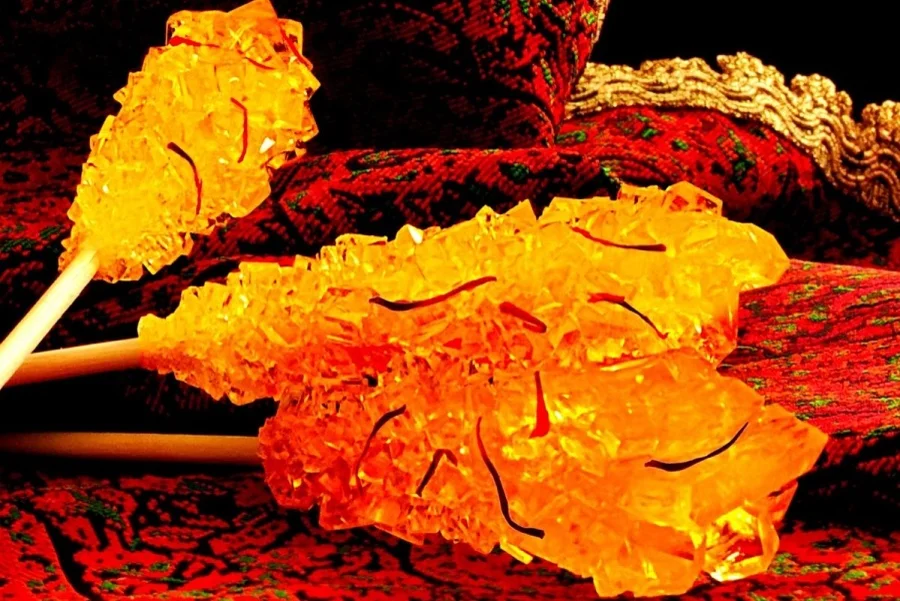
15. Saffron Rock Candy (Nabat)
Nabat, or Persian rock candy, is a classic sweetener used to enhance the flavor of tea and other warm drinks. Made from sugar crystals infused with saffron essence, it has a unique pale orange hue, a captivating saffron aroma, and a delightful flavor. Nabat is a popular treat in Iran, adding both sweetness and a touch of elegance to any drink.
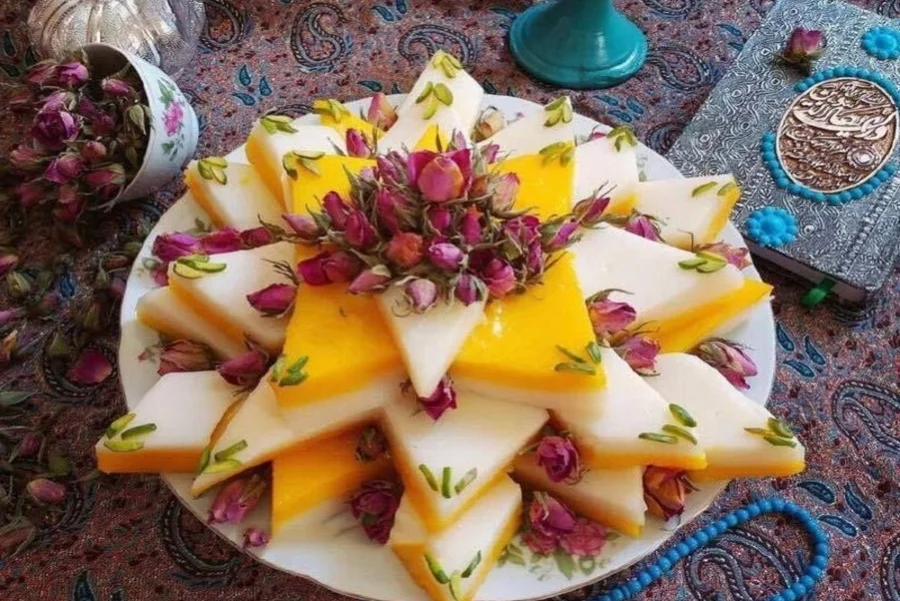
16. Masghati
Masghati is a popular Iranian dessert known for its soft, jelly-like texture. Made from starch, rosewater, saffron, and nuts, it is a gluten-free and vegan-friendly treat that can be enjoyed by many. With its rich sweetness, Masghati is especially popular in southern Iran, where it is cherished for its refreshing qualities and energy-boosting properties. Its simple yet flavorful ingredients make it a unique delicacy in Iranian cuisine.
17. Pashmak
Pashmak, often referred to as Persian cotton candy, is a unique type of candy floss that originated in Yazd, Iran. Pashmak stands apart from regular cotton candy with its unique texture and entirely different ingredients and preparation methods. It can be enjoyed on its own or paired with fruits, cakes, ice cream, puddings, and other Persian desserts. Occasionally, ground pistachios are used as a garnish to add extra flavor and crunch. Pashmak’s delicate sweetness and airy texture make it a beloved treat in Iranian cuisine.
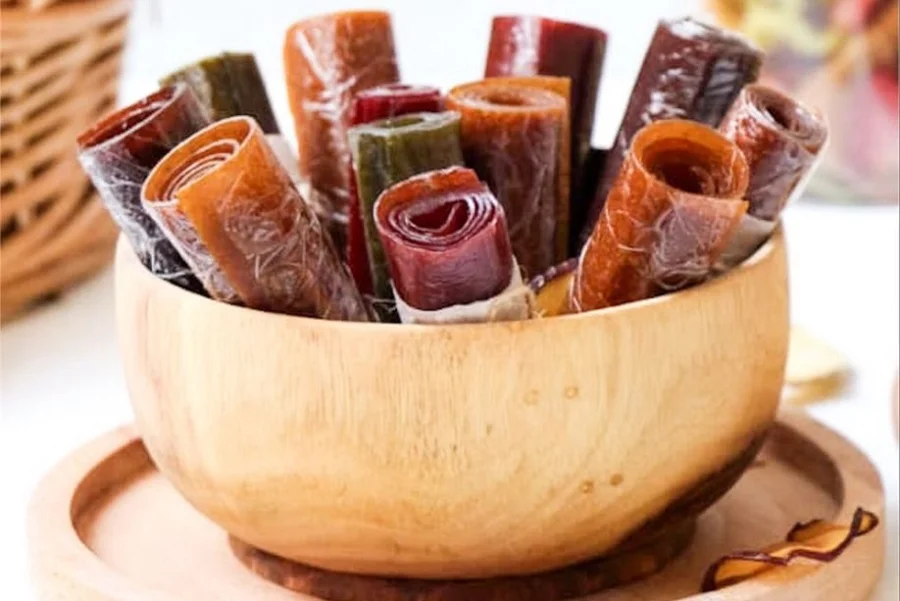
18. Lavashak
Lavashak is a popular Iranian snack made from fruit leathers. To make it, fruit purée is cooked and salted, then spread out in thin layers on a tray. The tray is typically dried on rooftops under the sun, giving Lavashak its signature chewy texture. This traditional treat comes in a variety of flavors, depending on the fruit used, and is enjoyed as a sweet, tangy, and slightly salty snack in Iran.
Lavashak, which originates from Iran, is known for its signature sour flavor. Many popular varieties of Lavashak have this tangy taste, and it is often served alongside other sour accompaniments like pomegranate paste, prunes, Gheisi (dried apricots), and Torshak. These additions enhance the tartness of the fruit leather, making Lavashak a unique and flavorful treat in Iranian cuisine.
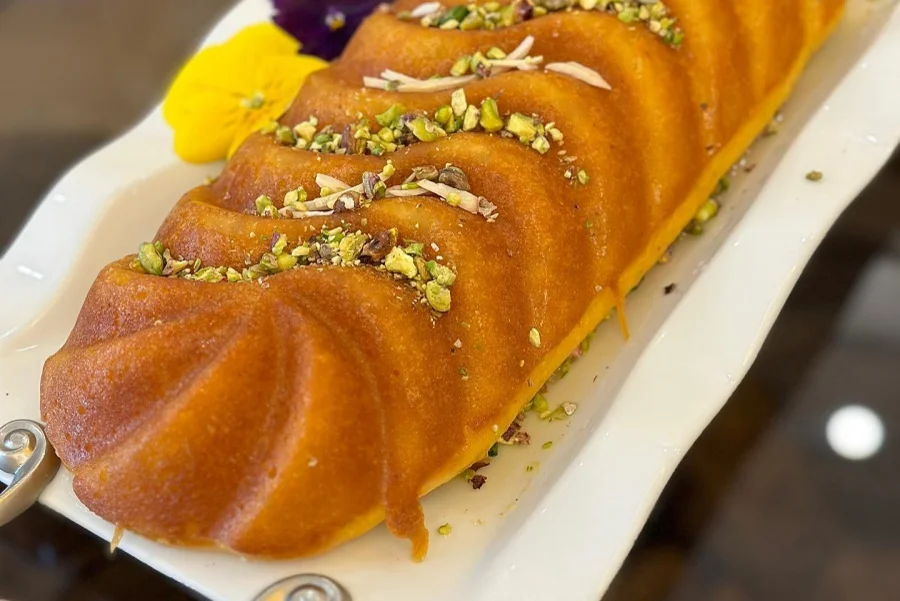
19. Khagineh
Khagineh is a simple yet flavorful Persian dish often referred to as a “sugar omelet” or a type of crêpe. Made with saffron, powdered cardamom, sugar, butter, and eggs, this dish combines a rich aroma, delightful texture, and sweet taste. It’s easy to prepare and can be enjoyed at various times of the day, whether as a dessert after dinner or as a breakfast, lunch, or brunch option. Its comforting flavors make it a beloved treat in Iranian cuisine.
20. Samanu
Samanu, often called Samanak or Saman, is a traditional Persian treat crafted from sprouted wheat. This rich, dark, and thick dessert is typically prepared by simmering wheat germ for several hours, resulting in a smooth, sweet paste. Samanu holds cultural significance, especially during Nowruz (Persian New Year) celebrations, and is enjoyed for its distinctive flavor and texture. Its preparation is a labor of love, with the result being a nutrient-packed, indulgent treat.
It’s important to note that Samanu is a patience-testing dessert, requiring several hours of slow simmering to achieve its smooth, rich consistency. As one of the most beloved Persian New Year desserts, Samanu holds a special place on the Haft-Seen table, symbolizing strength, endurance, and the sweetness of life. Its preparation is a time-honored tradition, showcasing both the complexity and simplicity of Persian culinary artistry.
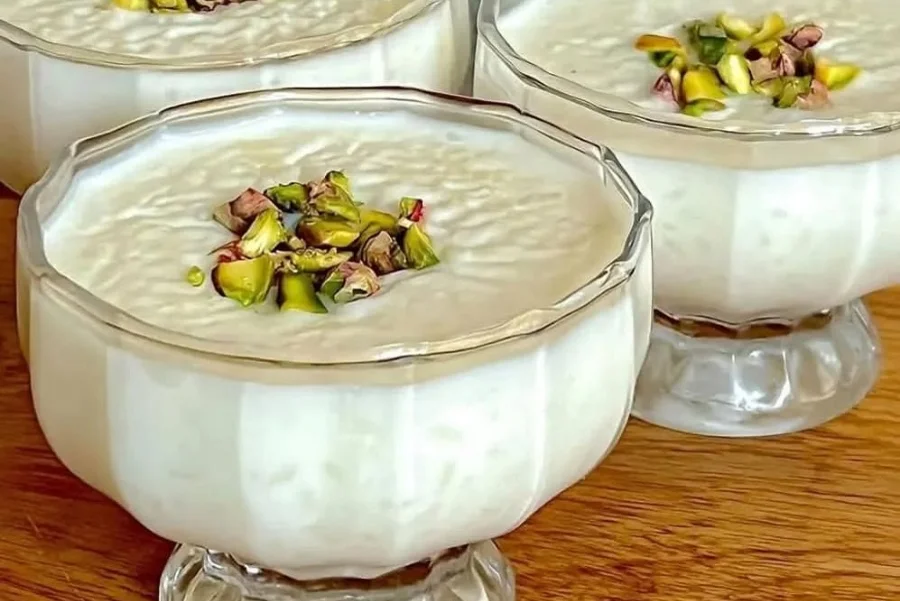
21. Shir Berenj (Rice Milk)
Shir Berenj is a traditional Persian rice pudding that is especially popular during Ramadan, typically served at Iftar, the evening meal that breaks the fast. This creamy dessert is made with rice, milk, and a hint of pure rosewater, which adds a delicate floral flavor. The combination of these simple ingredients creates a rich, comforting treat that’s both satisfying and soothing. It’s a beloved dish in Iranian cuisine, perfect for enjoying after a long day of fasting.
No trip to Iran is truly complete without experiencing this traditional dessert. Shir Berenj offers endless variations, allowing you to customize it to your taste. For a richer flavor, you can top it with melted chocolate, nuts, fruits, or even a drizzle of maple syrup. This versatility makes it a delightful treat that can be enjoyed in countless ways, whether you’re craving something classic or looking to add a personal twist.
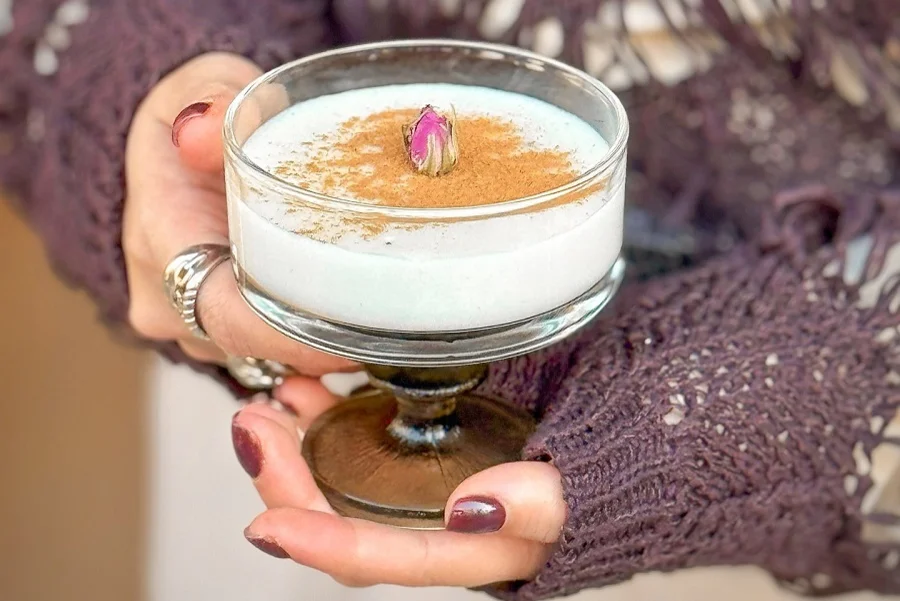
22. Fereni
Fereni is a classic Persian pudding made from simple yet flavorful ingredients like rice flour, rosewater, milk, sugar, and a hint of cardamom. This creamy dessert, often topped with pistachios and a sprinkle of cinnamon, is cherished for its smooth texture and aromatic fragrance.
Perfect as a comforting treat, Fereni is enjoyed by Iranians of all ages, whether as a light dessert or a sweet breakfast option.
Served warm or chilled, this simple Persian delicacy made with rice flour offers a comforting sweetness, perfect for warming up on chilly days or enjoying a refreshing treat in warmer weather.

